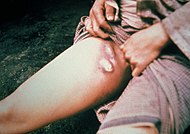Bubonic plague
From Wikipedia, the free encyclopedia
| Bubonic Plague Classification and external resources |
|
| A person infected with Bubonic Plague | |
| ICD-10 | 020.0 |
| ICD-9 | 050 |
| DiseasesDB | 14226 |
Bubonic plague is the best-known manifestation of the bacterial disease plague, caused by the bacterium Yersinia pestis (formerly known as Pasteurella pestis). The term "bubonic plague" was often used synonymously for plague, but it does in fact refer specifically to an infection that enters through the skin and travels through the lymphatics, as is often seen in flea-borne infections. Bubonic plague kills about 50% of infected patients in 3–7 days without treatment, and is believed by many to be the Black Death that swept through Europe in the 1340s, killing millions of people.The bubonic plague may have originated in ancient Egypt, according to a new study.[1]
Contents |
[edit] Pathology and transmission
The bubonic plague is an infection of the lymphatic system, usually resulting from the bite of an infected flea. The fleas are often found on rodents, such as rats and mice, and seek out other prey when their rodent hosts die. Once established, bacteria rapidly spread to the lymph nodes and multiply. Yersinia pestis Bacilli can resist phagocytosis and even reproduce inside phagocytes and kill them. As the disease progresses, the lymph nodes can hemorrhage and become swollen and necrotic. Bubonic plague can progress to lethal septicemic plague in some cases. The plague is also known to spread to the lungs and become the disease known as the pneumonic plague.
[edit] Symptoms
The most famous symptom of bubonic plague is swollen lymph glands, called buboes. These are commonly found in the armpits, groin or neck. The bubonic plague was the first step of the ongoing plague. Two other forms of the plague, pneumonic and septicemic, resulted after a patient with the bubonic plague developed pneumonia or blood poisoning.
Other symptoms include spots on the skin that are red at first and then turn black, heavy breathing, continuous blood vomiting, aching limbs, coughing and terrible pain. The pain is usually caused by the actual decaying, or decomposing of the skin while the infected person is still alive.
[edit] History
The deadly disease has claimed nearly 200 million lives (although there is some debate as to whether all of the plagues attributed to it are in fact the same disease). The first recorded epidemic ravaged the Byzantine Empire during the sixth century, and was named the Plague of Justinian after emperor Justinian I, who was infected but survived. The most infamous and devastating instance of the plague was the Black Death, which killed a quarter to half of the population of Europe. The Black Death is thought to have originated in the Gobi Desert. Carried by the fleas on rats, it spread along trade routes and reached the Crimea in 1346. In 1347 it spread to Constantinople and then Alexandria, killing thousands every day, and soon arrived in Western Europe.
The next few centuries were marked by several local outbreaks of lesser severity. The Great Plague of London, 1665–1666, was the last major outbreak of the bubonic plague in Europe. The plague resurfaced in the mid-18th century; like the Black Death, the Third Pandemic began in Central Asia. It spread worldwide, killing millions, into the early 20th century.
During the Second Sino-Japanese War, plague was used as a bacteriological weapon by the Imperial Japanese Army. These weapons were provided by Shirō Ishii's units and used in experiments on humans before being used on the field. For example, in 1940, the Imperial Japanese Army Air Service bombed Ningbo with fleas carrying the bubonic plague.[2] During the Khabarovsk War Crime Trials the accused, such as Major General Kiyashi Kawashima, testified that, in 1941, some 40 members of Unit 731 air-dropped plague-contaminated fleas on Changde. These operations caused epidemic plague outbreaks.[3]
[edit] Treatment
In modern times, several classes of antibiotics are effective in treating bubonic plague. These include the aminoglycosides streptomycin and gentamicin, the tetracyclines tetracycline and doxycycline and the fluoroquinolone ciprofloxacin. Patients with plague in the modern era usually recover completely with prompt diagnosis and treatment.[citation needed]
[edit] Further reading
- Alexander, John T. (2003, 1980). Bubonic Plague in Early Modern Russia: Public Health and Urban Disaster. Oxford, UK; New York, NY: Oxford University Press. ISBN 0195158180. OCLC 50253204.
- Carol, Benedict (1996). Bubonic Plague in Nineteenth-Century China. Stanford, CA: Stanford University Press. ISBN 0804726612. OCLC 34191853.
- Biddle, Wayne (2002). A Field Guide to Germs (2nd Anchor Books edition ed.). New York: Anchor Books. ISBN 140003051X. OCLC 50154403.
- Echenberg, Myron J. (2007). Plague Ports: The Global Urban Impact of Bubonic Plague, 1894-1901. New York, NY: New York University Press. ISBN 0814722326. OCLC 70292105.
- Little, Lester K. (2007). Plague and the End of Antiquity: The Pandemic of 541-750. New York, NY: Cambridge University Press. ISBN 9780521846394. OCLC 65361042.
- Scott, Susan, and C. J. Duncan (2001). Biology of Plagues: Evidence from Historical Populations. Cambridge, UK; New York, NY: Cambridge University Press. ISBN 0521801508. OCLC 44811929.
[edit] See also
[edit] Notes
- ^ Walker, Cameron (10 March, 2004). "Bubonic Plague Traced to Ancient Egypt". National Geographic News. http://news.nationalgeographic.com/news/2004/03/0310_040310_blackdeath.html. Retrieved on 2 April, 2009.
- ^ Japan triggered bubonic plague outbreak, doctor claims, [1], http://www.scaruffi.com/politics/wwii.html, A time-line of World War II, Scaruffi Piero. Prince Tsuneyoshi Takeda and Prince Mikasa received a special screening by Shirō Ishii of a film showing imperial planes loading germ bombs for bubonic dissemination over Ningbo in 1940. (Daniel Barenblatt, A Plague upon Humanity, 2004, p.32.)
- ^ Daniel Barenblatt, A Plague upon Humanity, 2004, pages 220–221.
|
||||||||||||||||||||||||||||||||||||||||||||||||||||||||||||||||||||||||||


